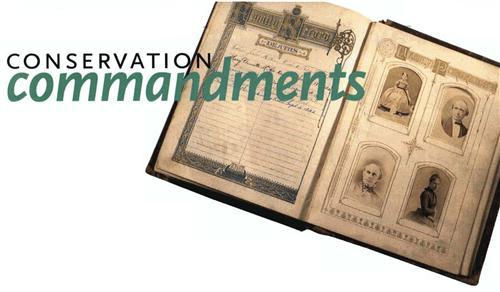
You’ve finally gotten your hands on what many researchers consider the Holy Grail of genealogy — your family Bible. These tomes are packed with valuable information; many contain page after page of birth, death and marriage records, and descendants of meticulous record-keepers may even be lucky enough to stumble upon newspaper clippings, funeral cards or other family mementos rucked inside the pages.
Now that you’ve got this sacred resource in your possession, you’ll want to keep it in tiptop condition, so you can pass it down to future generations of family researchers. Keep the following preservation pointers in mind when poring over the pages of your Bible.
seeing the light
During your genealogy research, you’ve probably waded through your fair share of brittle, yellowing documents. This effect is caused by paper’s ultra sensitivity to both fluorescent and natural light, which can cause fading or discoloration of the pages and leather binding. It’s a good idea to keep your Bible on a bookshelf that’s out of direct sunlight. You can also treat your pages with Archival Mist and Paper Bright — available from EK Success (800-524-1349); see <www.ptIp.com/bright.html> — which work together to deacidify paper and protect it from light damage. If your Bible’s already discolored, it’s best to send it to a professional conservator, who can stop further damage to your delicate pages.
beholding the bookshelf
While it may be tempting to seal your Bible in an airtight box, it’s actually better to put it on the shelf with other books. There, it will get the proper air circulation to stay mold-and mildew-free, and it’s not as subject to the fluctuating temperature and humidity of attics or basements.
The too-hot-and-humid temperatures in most basements and attics can cause Bible pages to curl, glue to melt and spines to loosen. And while there aren’t too many incidences of actual bookworms, other critters thrive in the dark, dank conditions of typical storage outlets — and you don’t want them munching on your beloved Bible!
When choosing a spot on the bookcase, store your Bible vertically with books of a similar size. If stored at an angle or near much shorter books, your Bible’s spine can bend and detach itself from the pages. Storing it with books that are the same height will give it proper support.
If you absolutely have to pack your Bible away, wrap it in acid-free tissue paper, which you can order from archival-supply stores such as The Preservation Station (703-598-1403, <www.preservesmart.com>, and tuck it in a custom-fitted box. Hollinger Corp. (800-634-0491,<www.genealogicalstorageproducts. com>) makes sturdy archival boxes in a variety of sizes. You’ll find more suppliers on page 62, inside our resource directory.
touching like an angel
You’re probably itching to crack open your Bible for research reference (or enjoyment), but remember; The more you handle your Bible, the more likely you are to smudge the ink, tear the pages and put stress on the structure of the book. Reduce handling time by copying down relevant information — names, dates, marked passages that may have special meaning — and working from your notes.
When you do have to handle your Bible, remove it from the shelf carefully, pulling from the middle of the spine. Keep in mind that books are built to be cradled in the hands or lap of the reader, so avoid laying it at a flat, 180-degree angle on your table. And of course, you should follow the basics of book handling: Always wash your hands; avoid eating, drinking or smoking in your work area; and never mark pages with paper clips or adhesive notes (pieces of scrap paper work best.]
finding salvation




